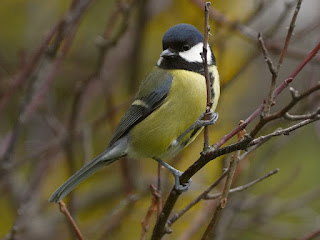A Blackbird in the Rose Garden was practising his song ready for the spring. He has to work up his phrases every year before he goes into full song.
The Redwings were still under their usual tree on the Parade Ground, annoyingly distant even when you're filming with a 1200 mm zoom.
There were plenty of small birds at Mount Gate, which is now the best place to see them as the light is better than in the shaded Flower Walk. Blue Tits came out in the dogwood bush ...
... and in a forsythia which is just starting to flower ...
... while a Coal Tit looked down from a high twig.
A Great Tit in the Rose Garden perched in front of the wattle bushes which are in bright yellow blossom ...
... and there was a Magpie in the flowering cherry plum tree.
The Robin at Henry Moore came out to collect some pine nuts.
The pigeon-eating Lesser Black-Backed Gull knows how fine he looks, and preens attentively to keep it that way.
The Grey Heron on the Serpentine island was also preening while it guarded the chicks in the nest. Let's hope we get a view of a chick before the nest disappears behind the hawthorn blossom.
The Great Crested Grebes from the nest at the bridge, at present having no rivals on the Long Water, had come up to the north end where the fishing is better.
There are still a few Shovellers here, though most of them have left.
The male Egyptian Goose waiting for his mate to emerge with goslings was wandering around the east side of the Vista, watched from the near shore by another pair. They didn't bother to shout at him: it seems to be only pairs that are seen as a threat.
The Egyptian female at the Round Pond was sheltering her goslings from the cold. I could see three.
But death waited on the gravel strip.
The Black Swan was following his Mute girlfriend, sometimes hooting melodiously.
Two swans on the Serpentine had come up too far and had run into the killer swan and his mate. They hastily fled to the relative safety of the east end of the lake.
A Canada x Greylag hybrid goose -- I think the only one we have at the moment -- was at the Dell restaurant.














Remarkable how the legs of the two lesser black-backs look so much less bright-yellow than Pigeon Eater's (whose skin tone could be taken for a yellow-legged gull).
ReplyDeletePresume that black swan doesn't range far - it's only a short trip down to St James' Park, where there are (or at least were) others. Wonder where it /he came from in the first place...
Some LBBs have legs that aren't yellow at all, off-whte like some Common Gulls or even pinkish like Herring Gulls. I attribute Pigeon Eater's very bright legs to lots of astaxanthin (a carotene pigment found in fat) in his pigeon-rich diet.
DeleteThe Black Swan was young when he arrived. We can never know how much of the geography of the London parks birds know un til they actually turn up in another place.
Great to see the blackbird: am very much looking forward to them displaying their full vocal repertoire this year :)
ReplyDeleteThere are sadly few of these lovely singers left in the park. For myself, I'm hoping that the very talented one at the back of my flat has survived another winter. At midsummer he starts at 4 am, a glorious treat.
DeleteHe hasn't started yet? Ours is making practice runs already by calling at 4:00-4:30 like clockwork!
DeleteOur Blackbirds are late starters. I'd say that this one was really just practising with subsong. However, a couple of days before this I met an American visitor who said that she had a Blackbird singing properly outside her hotel room window. Lucky woman.
Delete